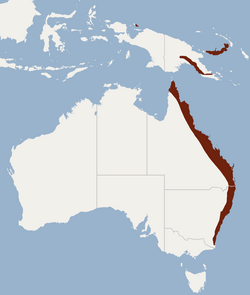Top Qs
Timeline
Chat
Perspective
Golden-tipped bat
Species of bat From Wikipedia, the free encyclopedia
Remove ads
The golden-tipped bat (Phoniscus papuensis) is a species of Microchiropteran in the family Vespertilionidae.[2] It is found in Papua New Guinea and in Australia, especially scattered along the eastern part of Australia.[3] The species is considered uncommon,[4] and is listed as endangered in Australia.[5]
Remove ads
Description
The golden-tipped bat has brown color and broken color patterns on its pelage;[3] the body is covered with woolly fur.[5] Broken color patterns support crypsis in the golden-tipped bat;[5] thick pelage and wooly fur provide thermal insulation.[5] The average weight of adults is 6.7 g (0.24 oz).[5]
The wings of the golden-tipped bat show a low aspect ratio, with low wing loading. (That is, the wing is broad.) These wing features of support slow flight.[6][7] Additionally, the large tail membrane aids the wing membrane in enabling tight turns in flight.[6][7] Rounded wing tips also contribute to high maneuverability in flight.[6][7]
The golden-tipped bat also uses echolocation for foraging, with frequencies of approximately 155 kHz to 60 kHz.[6]
Remove ads
Habitat and ecology
The golden-tipped bat has been mainly recorded in rainforest or wet sclerophyll forest.[3] It has also been recorded in dry sclerophyll forest. They live at elevations up to 1,000m.[3]
Roosting
They make diurnal roosts ranging from 0.5 to 9.0 m (1.6 to 29.5 ft) above the ground,[5] roosting on the branches of trees or in tree hollows.[5] Female bats use the canopy of a tree for a maternity site;[5] Roosts, and their broken patterns of pelage, enable this species to hide from their predators.[5]
Remove ads
Diet and foraging strategies
Diet
Araneida such as orb-weaver and big-jawed spiders are the main food of golden-tipped bats; as shown by the high proportion of Araneida body fragments among the particles lodged among the bats' teeth and fur.[6] Even though Araneida is a major food source for the golden-tipped bat, these bats also consume insects which belong to the insect orders Coleoptera (beetles) and Lepidoptera (butterflies and moths).[6]
Foraging strategies
The golden-tipped bat uses multiple foraging strategies to hunt. One is ground gleaning.[6] They also hover-glean, flying slowly and taking prey from elevated places such as high tree trunks.[6] The golden tipped bat use broad bandwidth echolocation to find precise localization of a target. Additionally, they use high frequency echolocation to find stationary prey such as spiders on their webs.[6]
References
Wikiwand - on
Seamless Wikipedia browsing. On steroids.
Remove ads


